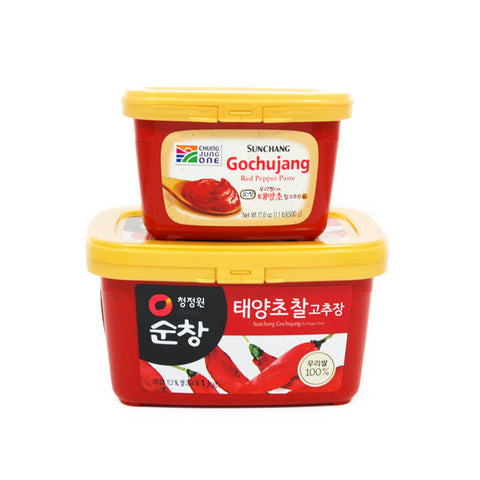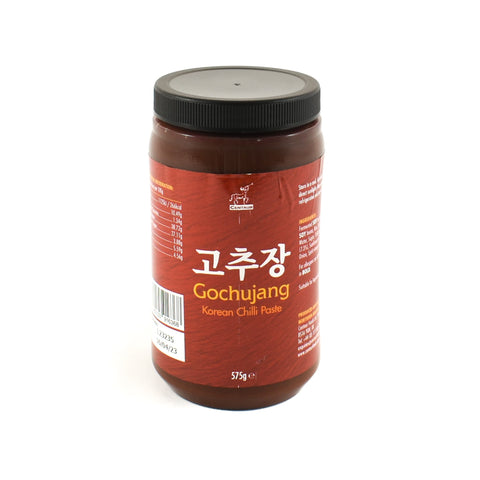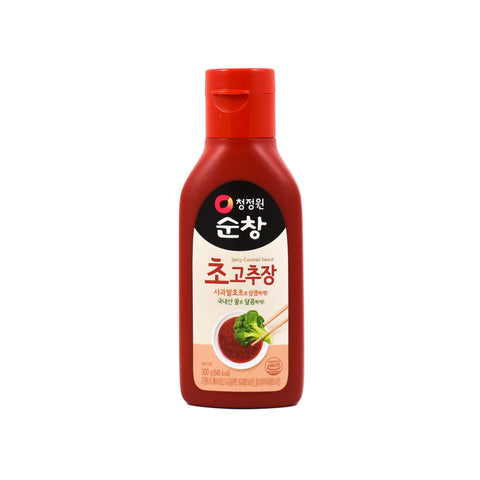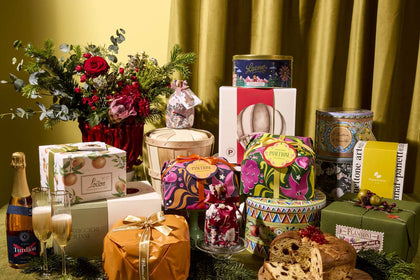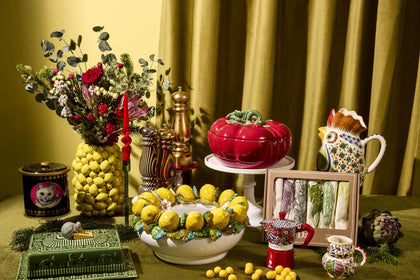Everything You Need To Know About Gochujang
by Ellie Edwards

Gochujang is a traditional Korean red chilli paste that brings a rich, spicy, umami flavour to soups, stews, and rice dishes.
Made from soybeans, red chilli peppers, and sticky rice, this deep-red condiment offers a savoury and slightly sweet flavour with a subtle heat.
Whether you’re curious about how to cook food with gochujang or what it tastes like, this guide will take you through everything, including a simple gochujang recipe.
What is gochujang? Understanding the Fermentation Process
Gochujang, meaning “chilli bean paste,” is a cornerstone of Korean cuisine and is often referred to as a traditional red chili paste. It’s a fermented paste made from red pepper powder (gochugaru), soybeans, and glutinous rice.
Its bold, complex flavour profile includes savoury, spicy, and sweet notes, making it a unique addition to many dishes. The fermentation process adds depth, creating a balance between chilli heat and umami richness.
History of Gochujang
Gochujang has a long history that stretches back many centuries in Korea. The earliest documented evidence of gochujang production dates to the 16th century during the Joseon Dynasty.
Traditionally, gochujang was crafted from fermented soybeans, rice, and red chili peppers. The fermentation process, which could span several years, imbued gochujang with its distinctive flavor and texture.
Over centuries, this spicy, umami-rich paste became a staple in Korean households, enhancing a variety of dishes from soups and stews to marinades.
The deep, complex flavors of gochujang are a testament to its long-standing cultural and culinary significance in Korea.
Ingredients of Gochujang
The magic of gochujang lies in its unique blend of ingredients. At its core, gochujang is made from:
-
fermented soybean powder
-
glutinous rice
-
gochugaru (Korean red chili peppers)
-
and salt.
The fermented soybean powder, known as meju, is derived from soybeans that have been fermented and ground into a fine powder, contributing to the paste’s umami depth.
Glutinous rice, or chapssal, adds a natural sweetness and a sticky texture, balancing the heat from the gochugaru.
These dried and crushed red chili peppers are what give gochujang its signature spicy kick. Finally, salt not only enhances the overall flavour but also acts as a preservative, ensuring the paste’s longevity.
This harmonious combination results in a condiment that is both savory and slightly sweet, perfect for a variety of Korean dishes.
How to Cook with Gochujang in Korean Dishes
With its hot and umami-rich flavours, gochujang is incredibly versatile. A little goes a long way in adding depth to soups, stews, and marinades.
It’s a staple in classic Korean dishes like jjigae (stew) and bokkeumbap (kimchi fried rice). You can also blend it with other ingredients like minced garlic, ginger, spring onions, and sesame oil to create ssamjang, a dipping sauce for Korean lettuce wraps.
Additionally, gochujang can be incorporated into various condiments and dipping sauces to enhance the flavor profile of many dishes.
Here are a few other dishes and more ways to use gochujang:
-
In Marinades: Use it as a base for bulgogi beef or chicken, and other meat dishes.
-
In Dressings: Mix with ginger and lime for a zesty salad dressing.
-
For Stir-Frying: Add a spoonful to stir-fries for a quick flavour boost.
Exciting recipes using gochujang
Cucumber Sangchae

A light and fresh salad, traditionally served as one of many vegetable side dishes in a colourful Korean meal. Great with spicy chicken wings!
Bulgogi Beef Ssam

Ssäm is a classic Korean dish meaning 'wrap'. This recipe is a lettuce wrap filled with marinated shredded beef – serve with a punchy dipping sauce.

Simply coated in a little oil and gochujang, then dehydrated – this is a brilliant crunchy snack to enjoy with a cool beer.
Dolsot Bibimbap

Heat your dolsot bowl, then fill with cooked rice and vegetables. Finish at the table with an egg and gochujang.

Once you mix classic ketchup with a little gochujang you'll never look back. Use the magic combo in a bacon butty that will really knock your socks off.
Sticky Pork Ribs

An unmissable recipe from the comprehensive K-Food cookbook, these pork ribs are glazed with gochujang and apricot jam. They're incredibly good!
Quick Gochujang Recipe
Want to make your own version of gochujang at home? Here’s a simple recipe that only takes a few hours and minutes to prepare:
Ingredients for Gochujang:
-
80g miso paste (chickpea or soy)
-
60ml maple syrup
-
60ml rice syrup
-
4 cloves garlic, minced
-
2-4 tbsp (30-60ml) water (to thin)
How to make Gochujang:
-
In a blender or food processor, combine the miso paste, chilli flakes, soy sauce, garlic, maple syrup, and rice syrup.
-
Blend until smooth, adding water a little at a time until you reach a thick paste consistency.
-
Taste and adjust as needed—more chilli for spice, maple syrup or rice syrup for sweetness, or soy sauce for saltiness.
-
Store in an airtight container in the fridge for up to two weeks.
This quick version of gochujang skips the fermentation process but still provides a rich and satisfying flavour.
What are the different types of gochujang I can buy?
This deep red gochujang paste has kimchi-like notes and lingering chilli heat. It’s excellent in traditional Korean recipes such as bibimbap, jjigae and ssamjang, or try it as a marinade for chicken stews.
This gluten free gochujang paste is made with fermented soybeans and red pepper powder for a spicy flavour. Mix the gochujang with gluten free soy sauce, a little sesame oil and white rice vinegar to make a sticky glaze for roasted or barbecued meat and vegetables.
This form of Korean gochujang, known as "hot pepper paste for sushi" is a mixture of the famous Korean chilli paste - gochujang - mixed together with vinegar. The vinegared gochujang is served at the table in Korean restaurants - most often to accompany fish or sashimi.
Frequently Asked Questions
What can I substitute for gochujang?
With super-savoury, fermented flavours and complex chilli notes, gochujang has a very distinctive taste which can’t be matched in other chilli sauces.
Can I substitute miso for gochujang?
Gochujang is a traditional condiment from South Korea. While gochujang’s fermented and chilli-forward flavour is hard to replicate, you can use a mix of miso paste, chilli flakes, and soy sauce in a pinch.
Is gochujang very hot or spicy?
Gochujang offers a balanced heat, with some brands being spicier than others. Its fermented soybeans help mellow the chilli’s sharpness, giving it a rounded, salty, savoury taste.
Is sriracha similar to gochujang?
Both sriracha and gochujang are chilli-based sauces, but sriracha is sweetener and tangy, while gochujang is thicker, spicier, and packed with umami flavours.
Gochujang is an umami Korean condiment made with soybeans, sticky rice and red pepper powder, and sriracha is a Thai sauce made with chilli, garlic and distilled vinegar.
While gochujang is complex with fermented flavours, sriracha is hot, sweet and sour. Sriracha is often used as a finishing sauce to drizzle over dishes, whereas gochujang is a thicker paste to use in marinades, braises and stews.
Gochujang is a versatile and flavourful condiment that is an essential part of Korean cuisine. With its rich history, unique ingredients, and various uses, gochujang is a must-have in any kitchen.
Whether you’re looking to add heat to your dishes or depth of flavor, gochujang is the perfect addition. With its long shelf life and ease of storage, gochujang is a convenient condiment to have on hand. So why not give gochujang a try and experience the bold flavors of Korea for yourself?
Shop all Korean ingredients here, and read more about the different types of chilli sauces here.

About the author
Ellie Edwards is a food writer for Sous Chef. Previously she worked at olive magazine, writing about exciting new ingredients, UK restaurants and travelling the world to find the best cinnamon buns. When she's not exploring the likes of Belize, Kerala and Zanzibar, Ellie loves rustling up a feast in her London kitchen, with a particular passion for porridge, sourdough and negronis.
